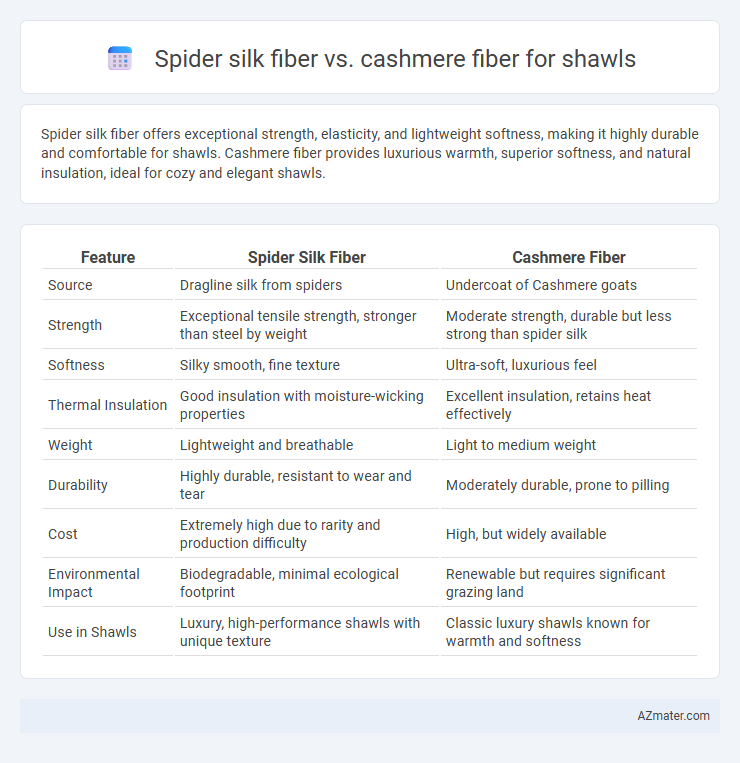Spider silk fiber offers exceptional strength, elasticity, and lightweight softness, making it highly durable and comfortable for shawls. Cashmere fiber provides luxurious warmth, superior softness, and natural insulation, ideal for cozy and elegant shawls.
Table of Comparison
| Feature | Spider Silk Fiber | Cashmere Fiber |
|---|---|---|
| Source | Dragline silk from spiders | Undercoat of Cashmere goats |
| Strength | Exceptional tensile strength, stronger than steel by weight | Moderate strength, durable but less strong than spider silk |
| Softness | Silky smooth, fine texture | Ultra-soft, luxurious feel |
| Thermal Insulation | Good insulation with moisture-wicking properties | Excellent insulation, retains heat effectively |
| Weight | Lightweight and breathable | Light to medium weight |
| Durability | Highly durable, resistant to wear and tear | Moderately durable, prone to pilling |
| Cost | Extremely high due to rarity and production difficulty | High, but widely available |
| Environmental Impact | Biodegradable, minimal ecological footprint | Renewable but requires significant grazing land |
| Use in Shawls | Luxury, high-performance shawls with unique texture | Classic luxury shawls known for warmth and softness |
Introduction to Spider Silk and Cashmere Fibers
Spider silk fiber, produced by spiders, boasts extraordinary tensile strength, elasticity, and lightweight properties, making it a remarkable natural material for textile applications. Cashmere fiber, derived from the undercoat of Cashmere goats, is renowned for its exceptional softness, warmth, and fine texture, highly prized in luxury shawls. Both fibers offer unique qualities: spider silk emphasizes durability and flexibility, while cashmere prioritizes insulation and comfort in high-end shawl production.
Origin and Production Process
Spider silk fiber originates from the silk-producing glands of spiders, primarily harvested through a delicate and labor-intensive process involving the careful extraction of silk threads from spider webs or forcibly reeling silk from captive spiders. Cashmere fiber is obtained from the undercoat of Cashmere goats, especially those in regions such as Mongolia, Iran, and the Himalayas, through meticulous combing or shearing during the molting season. The spider silk production is highly limited and artisanal, while cashmere fiber production relies on large-scale animal husbandry combined with careful sorting and dehairing to ensure softness and quality for shawls.
Physical Properties Comparison
Spider silk fiber exhibits exceptional tensile strength and elasticity, making it one of the strongest natural fibers with a breaking strength comparable to high-grade steel. Cashmere fiber is renowned for its softness and thermal insulation, offering excellent warmth-to-weight ratio but is less durable and less elastic than spider silk. While spider silk provides superior durability and flexibility, cashmere excels in lightweight comfort and thermal insulation, making each fiber suitable for different shawl applications based on desired physical properties.
Softness and Texture Differences
Spider silk fiber exhibits exceptional softness with a smooth, glossy texture that feels lightweight and luxurious against the skin. Cashmere fiber is renowned for its ultra-fine, plush softness, providing a warmer and more cushioned feel compared to spider silk. While spider silk offers superior tensile strength and a sleek finish, cashmere delivers a cozier texture with greater insulation for shawls.
Strength and Durability
Spider silk fiber exhibits exceptional tensile strength, surpassing most natural fibers, making it highly durable and resistant to wear in shawls. Cashmere fiber, though soft and luxurious, has lower strength and is more prone to pilling and abrasion over time. Choosing spider silk for shawls ensures enhanced longevity and resilience, especially in high-stress areas prone to stretching or friction.
Thermal Insulation and Breathability
Spider silk fiber exhibits exceptional thermal insulation attributes due to its unique protein structure, which traps heat effectively while maintaining lightweight comfort, making it ideal for shawls designed for cooler climates. Cashmere fiber, derived from the undercoat of cashmere goats, offers superior breathability alongside moderate thermal insulation, enabling temperature regulation that prevents overheating during wear. Shawls crafted from spider silk tend to provide enhanced warmth retention without compromising airflow, whereas cashmere shawls excel in moisture-wicking and softness, catering to users seeking balanced insulation and ventilation.
Eco-Friendliness and Sustainability
Spider silk fiber, known for its biodegradability and minimal resource consumption, offers a highly sustainable alternative to traditional textiles, while cashmere fiber, derived from goats, often raises concerns due to overgrazing and habitat degradation. The production of spider silk requires less water and land, reducing environmental impact compared to cashmere, which is associated with significant ecological strain. Choosing spider silk fiber for shawls supports eco-friendliness by promoting renewable materials with lower carbon footprints and enhanced recyclability.
Pricing and Market Value
Spider silk fiber commands a significantly higher price than cashmere due to its rarity, complex production process, and superior mechanical properties. While cashmere remains a luxury material with established market demand, spider silk's niche status and innovative appeal elevate its market value, often appealing to high-end, eco-conscious consumers. Pricing for spider silk shawls can exceed cashmere by several folds, reflecting scarcity and technological advancements in fiber harvesting.
Applications and Fashion Trends
Spider silk fiber is gaining traction in high-end shawl applications due to its exceptional strength, lightweight nature, and natural sheen, making it a luxurious and durable alternative to traditional fibers. Cashmere fiber, renowned for its softness and thermal insulation, remains a staple in fashion trends for shawls, favored for its comfort and elegance in cold climates. The fusion of spider silk and cashmere is emerging in avant-garde fashion, combining durability with softness to meet the demand for innovative, sustainable luxury shawls.
Conclusion: Choosing the Best Fiber for Shawls
Spider silk fiber offers exceptional strength, elasticity, and natural temperature regulation, making it an innovative and durable choice for luxury shawls. Cashmere fiber provides unparalleled softness, warmth, and lightweight comfort, preferred for classic elegance and coziness. Selecting the best fiber for shawls depends on prioritizing durability and cutting-edge performance with spider silk or embracing traditional softness and warmth with cashmere.

Infographic: Spider silk fiber vs Cashmere fiber for Shawl
 azmater.com
azmater.com